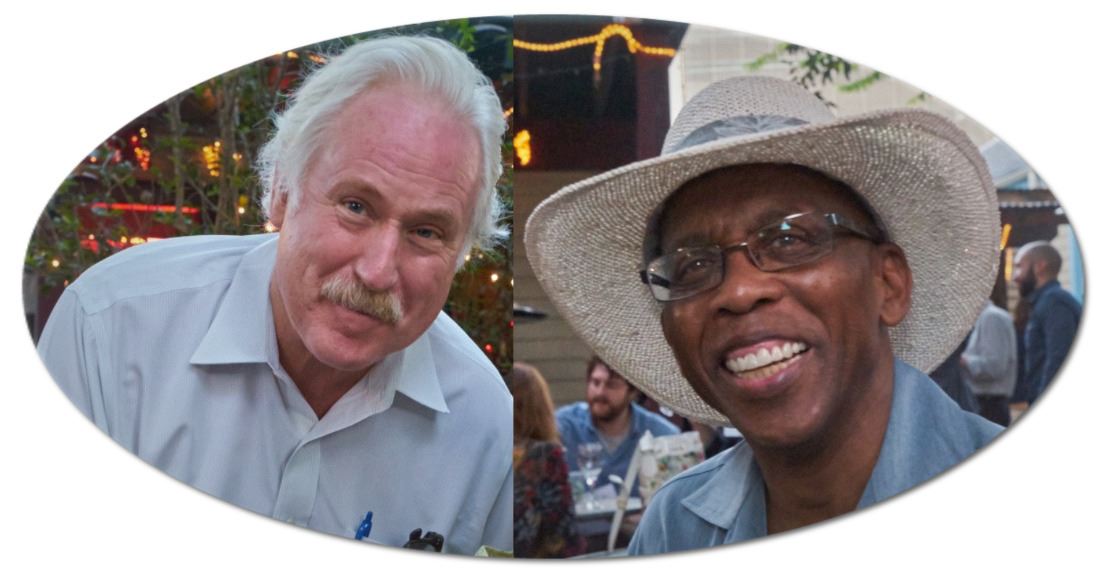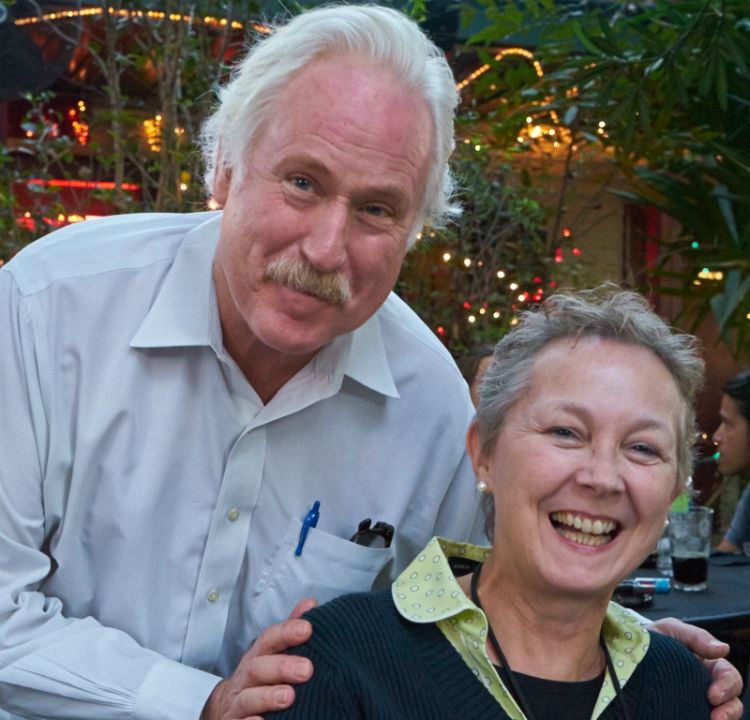A Tale in 2 Voices
ClassACT reunites colleagues and friends after 41 years
ClassACT is proud of our efforts to not only change the world, but reconnect classmates through this good work. We are excited to have reconnected colleagues and friends Charles Bush and Steve Milliken after 41 years. In this article, they reminisce on their work together as students with Phillips Brooks House, and discuss their continued efforts to make the world a better place with ClassACT.
 Steve Milliken and Charles Bush reuniting at a ClassACT event in New Orleans. Image Credit: Rick Weil
Steve Milliken and Charles Bush reuniting at a ClassACT event in New Orleans. Image Credit: Rick Weil
Charles Bush begins the tale: It was the summer of ’71, a time of an emerging sense of social responsibility for me and many of my colleagues on the Harvard campus. At Harvard, social responsibility was signified by Phillips Brooks House (PBH); where student activism and social needs were melded in the form of outreach programs. When the State of Massachusetts announced that it was considering creative alternatives to juvenile detention facilities, PBH responded with a novel proposal: PBH to sponsor and host a pilot program in which incarcerated, juvenile offenders would be released to the custody and daily responsibility of Harvard students. Guided by the need for a summer job no less than a desire to continue my involvement with PBH outreach, I leapt at the opportunity and was selected as a Counselor along with three of my colleagues, including one Steve Milliken.
Novel and ambitious, even by PBH standards, the program proved to be bred of unseasoned idealism and prematurely born (in other words, we were in way over our heads). We quickly discovered that classroom etiquette was a poor prescription for our young assignees’ street smarts and institutionally-honed survival skills.
Steve Milliken chimes in: Schooled to believe remedial education was one key to these teens’ successful reentry, I remember engaging a windowless Harvard classroom one morning to teach math. The minute I turned to the blackboard, the boy nearest the door flipped off the lights, and by the time I had fumbled my way over to the switch, the whole class was scattered. We spent the rest of the day and night searching for our charges all over Harvard Square and beyond.
 CB: With all their ivy ambiance, the Harvard Yard and the hallowed halls of PBH were no panacea. Likewise, our daily tutoring, counseling, mentoring, and guidance failed to effect the wholesale, miraculous transformation that I, for one, had so naively assumed. Still, we hung on and hung in, trying, testing, and stretching ourselves to new limits and learning to satisfy ourselves with a small breakthrough here or there. With the program’s phase out at the end of the summer, rather than swear off the concept, Steve and I huddled up and drafted a proposal to improve and extend it the following summer.
CB: With all their ivy ambiance, the Harvard Yard and the hallowed halls of PBH were no panacea. Likewise, our daily tutoring, counseling, mentoring, and guidance failed to effect the wholesale, miraculous transformation that I, for one, had so naively assumed. Still, we hung on and hung in, trying, testing, and stretching ourselves to new limits and learning to satisfy ourselves with a small breakthrough here or there. With the program’s phase out at the end of the summer, rather than swear off the concept, Steve and I huddled up and drafted a proposal to improve and extend it the following summer.
SM: One positive aspect of the program was our commitment to engage these young people in their homes and communities. While our ‘formal’ program at PBH only lasted the Summer, I stayed with several of the boys in the coming years. One young man, Tommy from Jamaica Plain, was the son of an alcoholic, who beat him regularly and severely as he drank more and more quarts of Pabst Blue Ribbon. At Christmas, Tommy asked if I’d come over to help him pick out a present for his father. When he took me into a bar, I asked whether getting his father alcohol made any sense. Tommy said nothing and just took me to the backroom fence, where the burgled inventory rivaled any retailer’s. The last police officer to arrest Tommy was also there doing his Christmas shopping.
My time with Phillips Brooks House, and with Charles, as well as with classmate Donna Brown (and another counselor I’ve entirely lost track of), taught me more to prepare me for a life in the trial courts and as a judge than any course or other experience at Harvard. I recall advocating for one of these children at the Roslindale Detention Center to keep him home, when so many had no one in their corner.
The greatest learning for me, sadly, was the depth of northern racism. I had been raised naively to believe that racism was a ‘Southern Problem.’ I had equally naively assumed the youth with whom we worked would join together, but fights between Black and White children were so spontaneously explosive that we ended up separating the groups for different program elements. I shouldn’t have been surprised, especially given what we continue to learn of this pernicious nationwide heritage.
CB: Somehow that effort faded in the haze of academic demands and eventual graduation, and along with it, any contact between Steve and me over the next forty-one years.
Then, in the spring of 2014, an inspired message cropped up in my email from ClassACT ’73, bearing the heading: “It's not too late to change the world.” So blatantly ambitious and improbably idealistic, the concept invited comparison to the PBH experience I shared with Steve forty-one years earlier. I recall initially thinking, this too is probably bred by unseasoned idealism. Then came the mention that one of ClassACT’s selected Bridge programs was a non-profit foundation called JusticeAid - improbably founded by one Steve Milliken. After confirming through ClassACT that this was in fact my former PBH program colleague, I signed on with the ClassACT entourage attending JusticeAid’s 2015 concert at the New Orleans House of Blues. Over the course of the weekend events, I reunited and reminisced with Steve; all of which flowed naturally into a renewed friendship and just as naturally to involvement with JusticeAid. Over the past four years, that involvement has expanded from attending JusticeAid’s benefit concerts to serving on its Host Committees. Discovering this gratifying work and rediscovering a lost friend after so many years, have been an inspiring reprisal of purpose for me. Thanks ClassACT ’73.
 Charles Bush living it up with ClassACT in NOLA!
Charles Bush living it up with ClassACT in NOLA!
SM: This to echo the great joy I took in reuniting with Charles Bush in New Orleans, 41 years after what he so aptly describes as our “novel and ambitious” efforts at Phillips Brooks House to change the lives of teenage boys released from Massachusetts ‘reform’ schools. We know what road good intentions pave, but I hasten to add that we vastly reduced the recidivism rates for these young folks who, at the time, faced well over a 90% chance of returning to detention.
I could not have been more delighted to meet up with Charles in New Orleans, and I am profoundly grateful to ClassACT for reuniting us, and for bringing many classmates to JusticeAid for events in DC and in NYC as well.
- Charles Bush and Steve Milliken, Class of ‘73
 Edited by Sallie Gouverneur, pictured left with Steve Milliken in NOLA. Image credit: Rick Weil
Edited by Sallie Gouverneur, pictured left with Steve Milliken in NOLA. Image credit: Rick Weil
